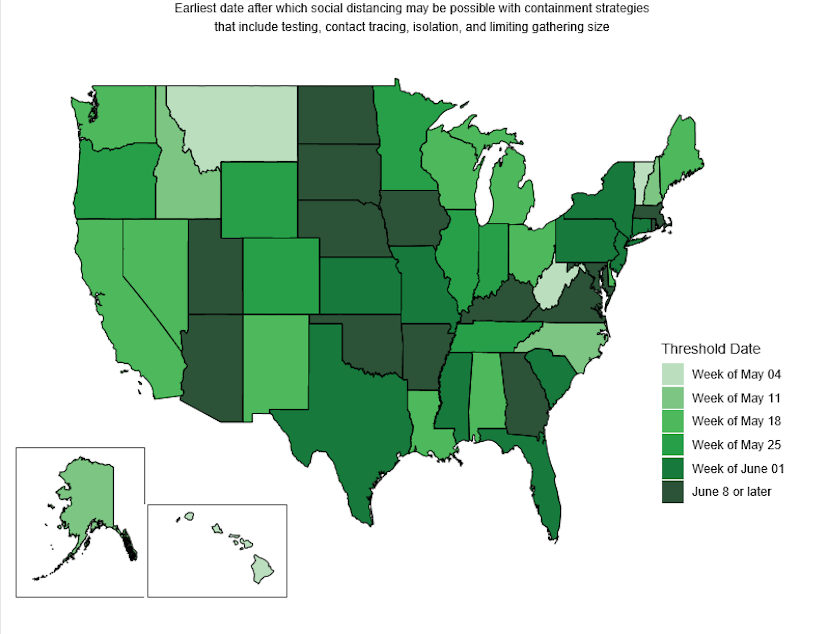Washington state may be able to ease social distancing in a month, according to models

New Covid-19 outbreak models suggest Washington state could possibly ease social distancing orders after May 18.
That’s as long as certain steps are taken to prevent a second wave of Covid-19 cases, such as limiting large gatherings and ramping up testing, contact tracing, and isolation capabilities.
The new models come from the University of Washington’s Institute for Health Metrics and Evaluation.
The institute's previous Covid-19 forecasts have received criticism from some epidemiologists, who've questioned the assumptions guiding the models. They contend the predictions been volatile and potentially too optimistic.
The latest Covid-19 projections by the Institute for Health Metrics and Evaluation suggest some states like Vermont and West Virginia may be able to ease back on social distancing measures sooner than Washington state, while states such as Iowa and Oklahoma may need to wait until the summer.
Questions surrounding when states will be able to safely begin reopening their economies are becoming more earnest.
“If I were a governor of a state, I would certainly not make a decision based just on our model,” said Dr. Chris Murray, director of the Institute for Health Metrics and Evaluation during a press briefing on Friday.
Sponsored
Murray said the institute aims to give policy makers a sense of when the risk of a Covid-19 resurgence will become lower, allowing the consideration of lifting the statewide lockdown.
“The longer you wait with social distancing, the less the number of infections there will be in the community to manage through containment strategies," Murray said. "So longer is better, but of course states are trying to balance economic and other trade-offs."
Like past models his team has created, Murray said the new projected reopening dates for each state are likely to change as new data becomes available.
A press release from the institute states that decisions to relax social distancing measures should also be informed by meeting critical metrics closer to the projected dates, including low numbers of estimated infections in the community — that's less than one infection per one million people.
Public health officials have warned repeatedly of the dangers of rolling back social distancing measures too soon, a concern echoed by Murray.
Sponsored
Jeff Duchin, health officer for Public Health – Seattle & King County, has stated repeatedly that lifting those orders too soon will likely result in a fierce resurgence of Covid-19 cases.
Duchin said on Friday that he could not comment in detail on the new Institute for Health Metrics and Evaluation predictions as he had not yet seen them. But he said that in King County, and at the state level, public health officials believe at least another month under current measures is needed.
“So I think that conclusion is consistent with our own internal thinking,” Duchin said of the projections for Washington state.
He said there are still a lot of things that need to be in place before the state can begin to reopen, and they'll need to observe a continued decline in transmission and the number of Covid-19 cases before beginning to roll back measures.
Ruth Etzioni is a biostatistician in the public health services division of the Fred Hutchinson Cancer Research Center. She’s skeptical of the Institute for Health Metrics and Evaluation projections.
Sponsored
“The IHME model is an empirical model that is not built for guidance about specific policies," Etzioni said via email. "I am concerned that it is not being used or interpreted properly."
Etzioni added that social distancing is a multi-faceted package of restrictions, and relaxing different components will result in different consequences.
“I don’t believe the IHME model captures the effects of each of these components separately so it cannot be used to inform these more practical, detailed policy questions.”
Murray from the Institute for Health Metrics and Evaluation has acknowledged criticism of previous projections, and reiterated that there’s uncertainty surrounding the modeling.
He said on Friday that the institute continues to revise its models for accuracy, but that he believes the projections have been in the right ballpark so far.




